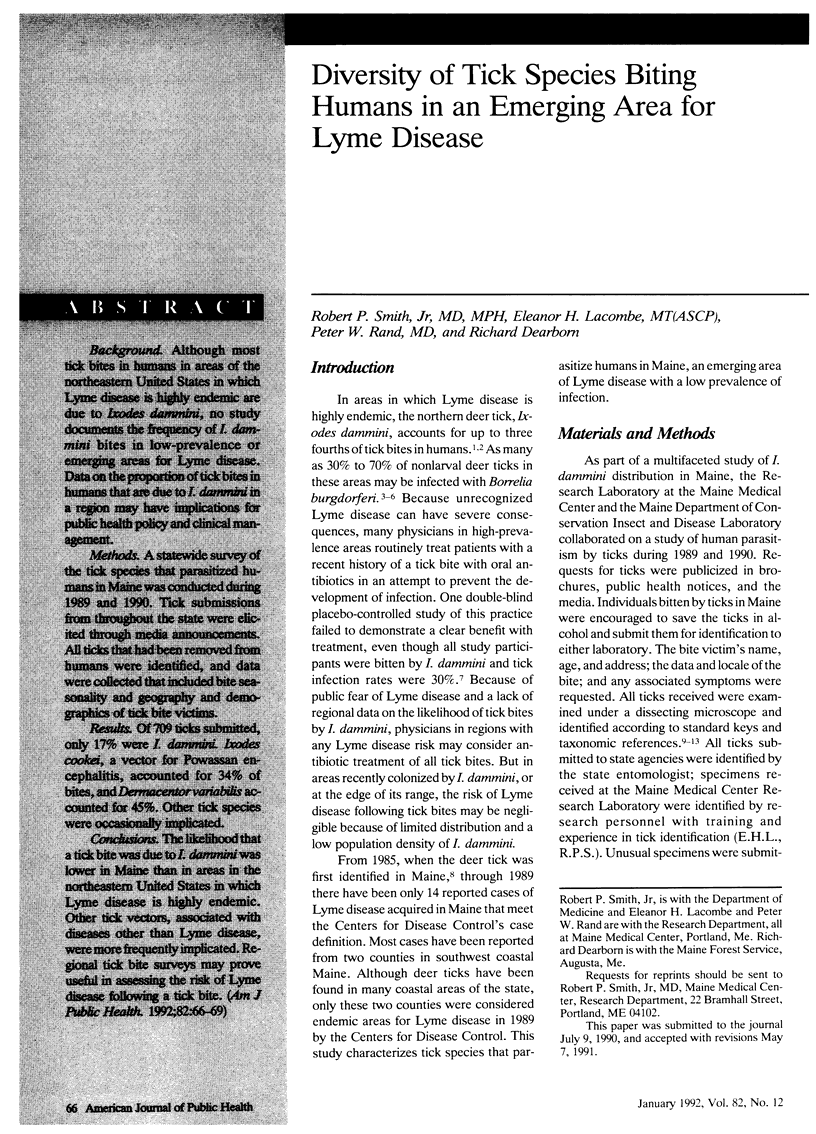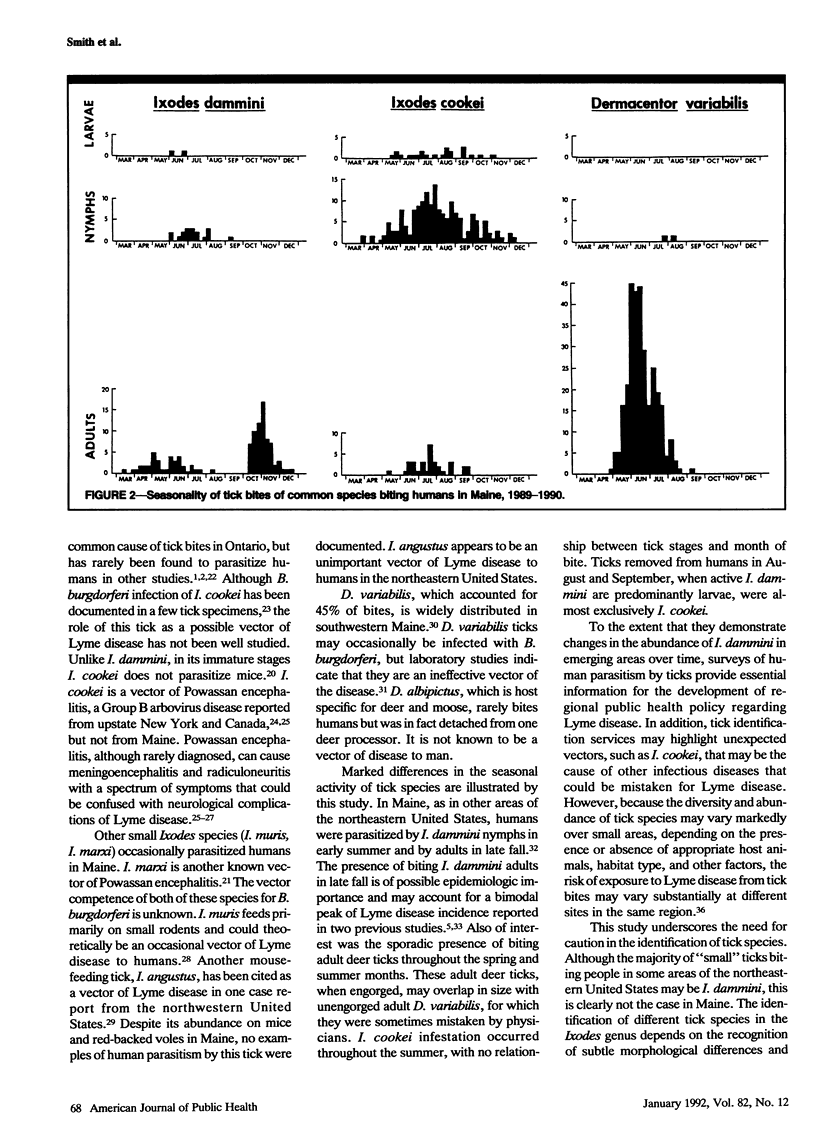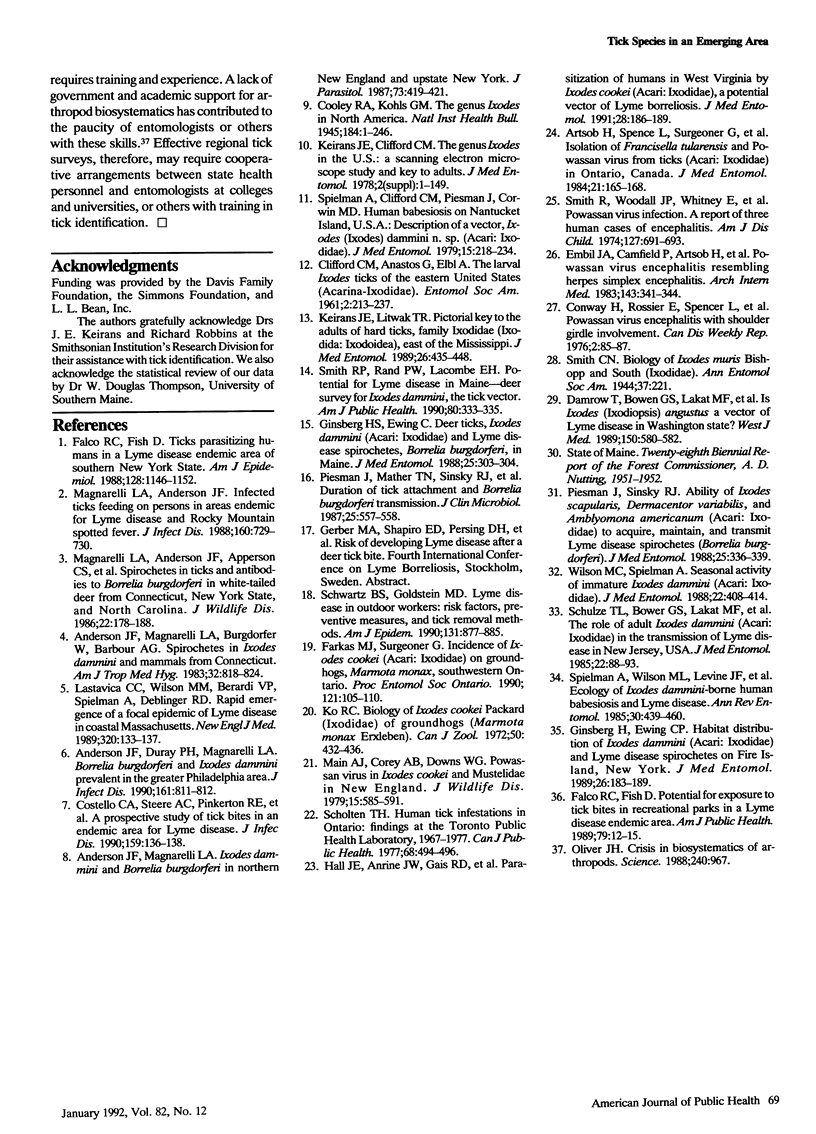Abstract
BACKGROUND. Although most tick bites in humans in areas of the northeastern United States in which Lyme disease is highly endemic are due to Ixodes dammini, no study documents the frequency of I. dammini bites in low-prevalence or emerging areas for Lyme disease. Data on the proportion of tick bites in humans that are due to I. dammini in a region may have implications for public health policy and clinical management. METHODS. A statewide survey of the tick species that parasitized humans in Maine was conducted during 1989 and 1990. Tick submissions from throughout the state were elicited through media announcements. All ticks that had been removed from humans were identified, and data were collected that included bite seasonality and geography and demographics of tick bite victims. RESULTS. Of 709 ticks submitted, only 17% were I. dammini. Ixodes cookei, a vector for Powassan encephalitis, accounted for 34% of bites, and Dermacentor variabilis accounted for 45%. Other tick species were occasionally implicated. CONCLUSIONS. The likelihood that a tick bite was due to I. dammini was lower in Maine than in areas in the northeastern United States in which Lyme disease is highly endemic. Other tick vectors, associated with diseases other than Lyme disease, were more frequently implicated. Regional tick bite surveys may prove useful in assessing the risk of Lyme disease following a tick bite.
Full text
PDF



Selected References
These references are in PubMed. This may not be the complete list of references from this article.
- Anderson J. F., Duray P. H., Magnarelli L. A. Borrelia burgdorferi and Ixodes dammini prevalent in the greater Philadelphia area. J Infect Dis. 1990 Apr;161(4):811–812. doi: 10.1093/infdis/161.4.811. [DOI] [PubMed] [Google Scholar]
- Anderson J. F., Magnarelli L. A., Burgdorfer W., Barbour A. G. Spirochetes in Ixodes dammini and mammals from Connecticut. Am J Trop Med Hyg. 1983 Jul;32(4):818–824. doi: 10.4269/ajtmh.1983.32.818. [DOI] [PubMed] [Google Scholar]
- Anderson J. F., Magnarelli L. A., McAninch J. B. Ixodes dammini and Borrelia burgdorferi in northern New England and upstate New York. J Parasitol. 1987 Apr;73(2):419–421. [PubMed] [Google Scholar]
- Artsob H., Spence L., Surgeoner G., McCreadie J., Thorsen J., Th'ng C., Lampotang V. Isolation of Francisella tularensis and Powassan virus from ticks (Acari: Ixodidae) in Ontario, Canada. J Med Entomol. 1984 Mar 30;21(2):165–168. doi: 10.1093/jmedent/21.2.165. [DOI] [PubMed] [Google Scholar]
- Costello C. M., Steere A. C., Pinkerton R. E., Feder H. M., Jr A prospective study of tick bites in an endemic area for Lyme disease. J Infect Dis. 1989 Jan;159(1):136–139. doi: 10.1093/infdis/159.1.136. [DOI] [PubMed] [Google Scholar]
- Damrow T., Freedman H., Lane R. S., Preston K. L. Is Ixodes (ixodiopsis) angustus a vector of Lyme disease in Washington State? West J Med. 1989 May;150(5):580–582. [PMC free article] [PubMed] [Google Scholar]
- Embil J. A., Camfield P., Artsob H., Chase D. P. Powassan virus encephalitis resembling herpes simplex encephalitis. Arch Intern Med. 1983 Feb;143(2):341–343. [PubMed] [Google Scholar]
- Falco R. C., Fish D. Potential for exposure to tick bites in recreational parks in a Lyme disease endemic area. Am J Public Health. 1989 Jan;79(1):12–15. doi: 10.2105/ajph.79.1.12. [DOI] [PMC free article] [PubMed] [Google Scholar]
- Falco R. C., Fish D. Ticks parasitizing humans in a Lyme disease endemic area of southern New York State. Am J Epidemiol. 1988 Nov;128(5):1146–1152. doi: 10.1093/oxfordjournals.aje.a115057. [DOI] [PubMed] [Google Scholar]
- Ginsberg H. S., Ewing C. P. Deer ticks, Ixodes dammini (Acari: Ixodidae), and Lyme disease spirochetes, Borrelia burgdorferi, in Maine. J Med Entomol. 1988 Jul;25(4):303–304. doi: 10.1093/jmedent/25.4.303. [DOI] [PubMed] [Google Scholar]
- Ginsberg H. S., Ewing C. P. Habitat distribution of Ixodes dammini (Acari: Ixodidae) an Lyme disease spirochetes on Fire Island, New York. J Med Entomol. 1989 May;26(3):183–189. doi: 10.1093/jmedent/26.3.183. [DOI] [PubMed] [Google Scholar]
- Hall J. E., Amrine J. W., Jr, Gais R. D., Kolanko V. P., Hagenbuch B. E., Gerencser V. F., Clark S. M. Parasitization of humans in West Virginia by Ixodes cookei (Acari: Ixodidae), a potential vector of Lyme borreliosis. J Med Entomol. 1991 Jan;28(1):186–189. doi: 10.1093/jmedent/28.1.186. [DOI] [PubMed] [Google Scholar]
- Keirans J. E., Clifford C. M. The genus Ixodes in the United States: a scanning electron microscope study and key to the adults. J Med Entomol Suppl. 1978 Jul 20;2:1–149. doi: 10.1093/jmedent/15.suppl2.1. [DOI] [PubMed] [Google Scholar]
- Keirans J. E., Litwak T. R. Pictorial key to the adults of hard ticks, family Ixodidae (Ixodida: Ixodoidea), east of the Mississippi River. J Med Entomol. 1989 Sep;26(5):435–448. doi: 10.1093/jmedent/26.5.435. [DOI] [PubMed] [Google Scholar]
- Ko R. C. Biology of Ixodes cookei Packard (Ixodidae) of groundhogs (Marmota monax Erxleben). Can J Zool. 1972 Apr;50(4):433–436. doi: 10.1139/z72-061. [DOI] [PubMed] [Google Scholar]
- Lastavica C. C., Wilson M. L., Berardi V. P., Spielman A., Deblinger R. D. Rapid emergence of a focal epidemic of Lyme disease in coastal Massachusetts. N Engl J Med. 1989 Jan 19;320(3):133–137. doi: 10.1056/NEJM198901193200301. [DOI] [PubMed] [Google Scholar]
- Magnarelli L. A., Anderson J. F., Apperson C. S., Fish D., Johnson R. C., Chappell W. A. Spirochetes in ticks and antibodies to Borrelia burgdorferi in white-tailed deer from Connecticut, New York State, and North Carolina. J Wildl Dis. 1986 Apr;22(2):178–188. doi: 10.7589/0090-3558-22.2.178. [DOI] [PubMed] [Google Scholar]
- Magnarelli L. A., Anderson J. F. Infected ticks feeding on persons in areas endemic for Lyme disease and Rocky Mountain spotted fever. J Infect Dis. 1989 Oct;160(4):729–730. doi: 10.1093/infdis/160.4.729. [DOI] [PubMed] [Google Scholar]
- Main A. J., Carey A. B., Downs W. G. Powassan virus in Ixodes cookei and Mustelidae in New England. J Wildl Dis. 1979 Oct;15(4):585–591. doi: 10.7589/0090-3558-15.4.585. [DOI] [PubMed] [Google Scholar]
- Oliver J. H., Jr Crisis in biosystematics of arthropods. Science. 1988 May 20;240(4855):967–967. doi: 10.1126/science.3368789. [DOI] [PubMed] [Google Scholar]
- Piesman J., Mather T. N., Sinsky R. J., Spielman A. Duration of tick attachment and Borrelia burgdorferi transmission. J Clin Microbiol. 1987 Mar;25(3):557–558. doi: 10.1128/jcm.25.3.557-558.1987. [DOI] [PMC free article] [PubMed] [Google Scholar]
- Piesman J., Sinsky R. J. Ability to Ixodes scapularis, Dermacentor variabilis, and Amblyomma americanum (Acari: Ixodidae) to acquire, maintain, and transmit Lyme disease spirochetes (Borrelia burgdorferi). J Med Entomol. 1988 Sep;25(5):336–339. doi: 10.1093/jmedent/25.5.336. [DOI] [PubMed] [Google Scholar]
- Scholten T. Human tick infestations in Ontario: findings at the Toronto Public Health Laboratory, 1967-1977. Can J Public Health. 1977 Nov-Dec;68(6):494–496. [PubMed] [Google Scholar]
- Schulze T. L., Bowen G. S., Lakat M. F., Parkin W. E., Shisler J. K. The role of adult Ixodes dammini (Acari: Ixodidae) in the transmission of Lyme disease in New Jersey, USA. J Med Entomol. 1985 Jan 18;22(1):88–93. doi: 10.1093/jmedent/22.1.88. [DOI] [PubMed] [Google Scholar]
- Smith R. P., Jr, Rand P. W., Lacombe E. H. Potential for Lyme disease in Maine: deer survey of distribution of Ixodes dammini, the tick vector. Am J Public Health. 1990 Mar;80(3):333–335. doi: 10.2105/ajph.80.3.333. [DOI] [PMC free article] [PubMed] [Google Scholar]
- Smith R., Woodall J. P., Whitney E., Deibel R., Gross M. A., Smith V., Bast T. F. Powassan virus infection. A report of three human cases of encephalitis. Am J Dis Child. 1974 May;127(5):691–693. doi: 10.1001/archpedi.1974.02110240077010. [DOI] [PubMed] [Google Scholar]
- Spielman A., Clifford C. M., Piesman J., Corwin M. D. Human babesiosis on Nantucket Island, USA: description of the vector, Ixodes (Ixodes) dammini, n. sp. (Acarina: Ixodidae). J Med Entomol. 1979 Mar 23;15(3):218–234. doi: 10.1093/jmedent/15.3.218. [DOI] [PubMed] [Google Scholar]
- Spielman A., Wilson M. L., Levine J. F., Piesman J. Ecology of Ixodes dammini-borne human babesiosis and Lyme disease. Annu Rev Entomol. 1985;30:439–460. doi: 10.1146/annurev.en.30.010185.002255. [DOI] [PubMed] [Google Scholar]
- Wilson M. L., Spielman A. Seasonal activity of immature Ixodes dammini (Acari: Ixodidae). J Med Entomol. 1985 Jul 26;22(4):408–414. doi: 10.1093/jmedent/22.4.408. [DOI] [PubMed] [Google Scholar]


